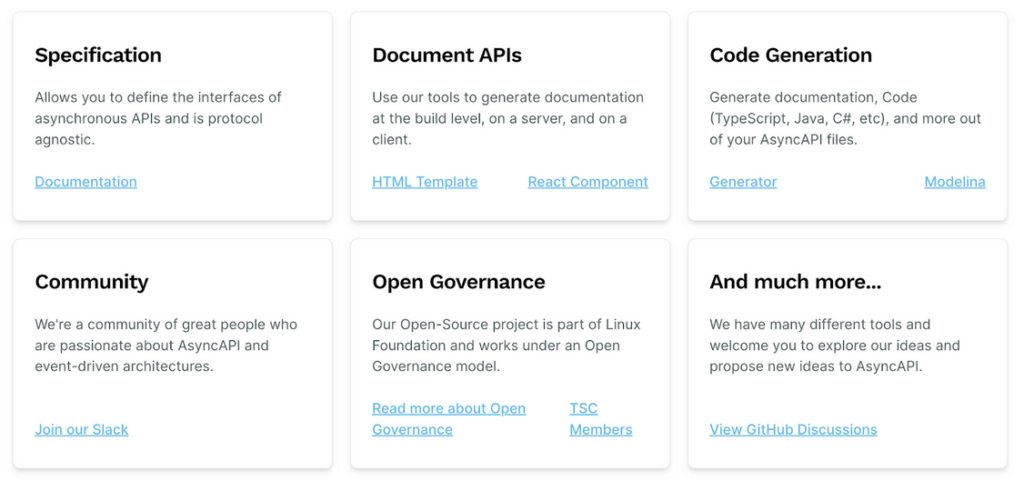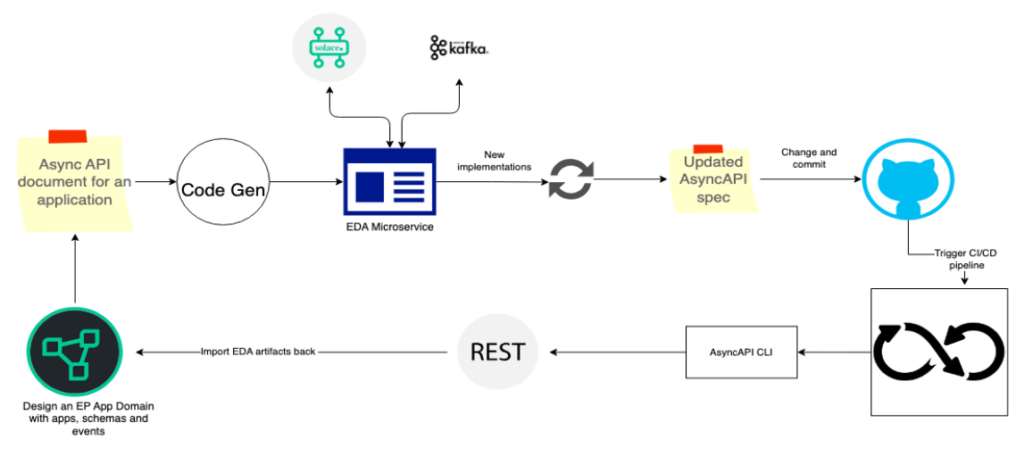The AsyncAPI specification emerged in response to the growing need for a standardized and comprehensive framework that addresses the challenges of designing and documenting asynchronous APIs. It is a collaborative effort of leading tech companies, open source communities, and individual contributors who actively participated in the creation and evolution of the AsyncAPI specification.
Various approaches exist for implementing asynchronous interactions and APIs, each tailored to specific use cases and requirements. Despite this diversity, these approaches fundamentally share a common baseline of key concepts. Whether it’s messaging queues, event-driven architectures, or other asynchronous paradigms, the overarching principles remain consistent.
Leveraging this shared foundation, AsyncAPI taps into a spectrum of techniques, providing developers with a unified understanding of essential concepts. This strategic approach not only fosters interoperability but also enhances flexibility across various asynchronous implementations, delivering significant benefits to developers.
From planning to execution: Design and runtime phases of EDA
The design time and runtime refer to distinct phases in the lifecycle of an event-driven system, each serving distinct purposes:
Design time: This phase occurs during the design and development of the event-driven system, where architects and developers plan and structure the system engaging in activities around:
- Designing event flows
- Schema definition
- Topic or channel design
- Error handling and retry policies
- Security considerations
- Versioning strategies
- Metadata management
- Testing and validation
- Documentation
- Collaboration and communication
- Performance considerations
- Monitoring and observability
The design phase yields assets, including a well-defined and configured messaging infrastructure. This encompasses components such as brokers, queues, topics/channels, schemas, and security settings, all tailored to meet specific requirements. The nature of these assets may vary based on the choice of the messaging system.
Runtime: This phase occurs when the system is in operation, actively processing events based on the design-time configurations and settings, responding to triggers in real time.
- Dynamic event routing
- Concurrency management
- Scalability adjustments
- Load balancing
- Distributed tracing
- Alerting and notification
- Adaptive scaling
- Monitoring and troubleshooting
- Integration with external systems
The output of this phase is the ongoing operation of the messaging platform, with messages being processed, routed, and delivered to subscribers based on the configured settings.
Role of AsyncAPI
AsyncAPI plays a pivotal role in the asynchronous API design and documentation. Its significance lies in standardization, providing a common and consistent framework for describing asynchronous APIs. AsyncAPI details crucial aspects such as message formats, channels, and protocols, enabling developers and stakeholders to understand and integrate with asynchronous systems effectively.
It should also be noted that the AsyncAPI specification serves as more than documentation; it becomes a communication contract, ensuring clarity and consistency in the exchange of messages between different components or services. Furthermore, AsyncAPI facilitates code generation, expediting the development process by offering a starting point for implementing components that adhere to the specified communication patterns.

In essence, AsyncAPI helps bridge the gap between design-time decisions and the practical implementation and operation of systems that rely on asynchronous communication.
Bridging the gap
Let’s explore a scenario involving the development and consumption of an asynchronous API, coupled with a set of essential requirements:
- Designing an asynchronous API in an event-driven architecture (EDA):
- Define the events, schema, and publish/subscribe permissions of an EDA service
- Expose the service as an asynchronous API
- Generating AsyncAPI specification:
- Use the AsyncAPI standard to generate a specification of the asynchronous API
- Utilizing GitHub for storage and version control:
- Check in the AsyncAPI specification into GitHub, leveraging it as both a storage system and a version control system
- Configuring GitHub workflow for document review:
- Set up a GitHub action designed to review pull requests (PRs) related to changes in the AsyncAPI document
- If changes are detected, initiate a validation process
- Upon a successful review and PR approval, proceed to merge the changes
- Synchronize the updated API design with the design time
- Set up a GitHub action designed to review pull requests (PRs) related to changes in the AsyncAPI document
This workflow ensures that design-time and runtime components remain in sync consistently. The feasibility of this process is grounded in the use of the AsyncAPI for the API documentation. Additionally, the AsyncAPI tooling ecosystem supports validation and code generation that makes it possible to keep the design time and runtime in sync.
Putting the scenario into action

Let us consider Solace Event Portal as the tool for building an asynchronous API and Solace PubSub+ Broker as the messaging system.
An event portal is a cloud-based event management tool that helps in designing EDAs. In the design phase, the portal facilitates the creation and definition of messaging structures, channels, and event-driven contracts. Leveraging the capabilities of Solace Event Portal, we model the asynchronous API and share the crucial details, such as message formats, topics, and communication patterns, as an AsyncAPI document.
We can further enhance this process by providing REST APIs that allow for the dynamic updating of design-time assets, including events, schemas, and permissions. GitHub actions are employed to import AsyncAPI documents and trigger updates to the design-time assets.
The synchronization between design-time and runtime components is made possible by adopting AsyncAPI as the standard for documenting asynchronous APIs. The AsyncAPI tooling ecosystem, encompassing validation and code generation, plays a pivotal role in ensuring the seamless integration of changes. This workflow guarantees that any modifications to the AsyncAPI document efficiently translate into synchronized adjustments in both design-time and runtime aspects.
Conclusion
Keeping the design time and runtime in sync is essential for a seamless and effective development lifecycle. When the design specifications closely align with the implemented runtime components, it promotes consistency, reliability, and predictability in the functioning of the system.
The adoption of the AsyncAPI standard is instrumental in achieving a seamless integration between the design-time and runtime components of asynchronous APIs in EDAs. The use of AsyncAPI as the standard for documenting asynchronous APIs, along with its robust tooling ecosystem, ensures a cohesive development lifecycle.
The effectiveness of this approach extends beyond specific tools, offering a versatile and scalable solution for building and maintaining asynchronous APIs in diverse architectural environments.
Author
Post contributed by Giri Venkatesan, Solace


